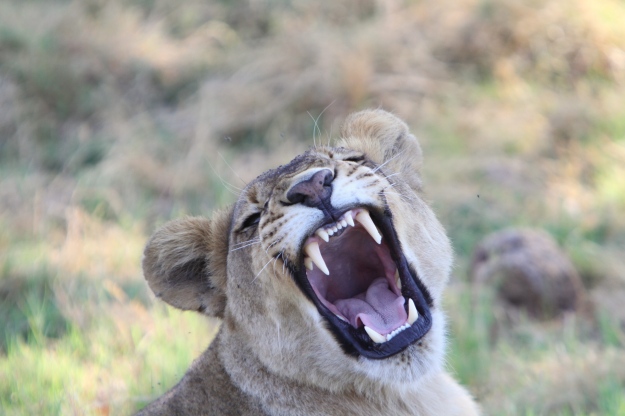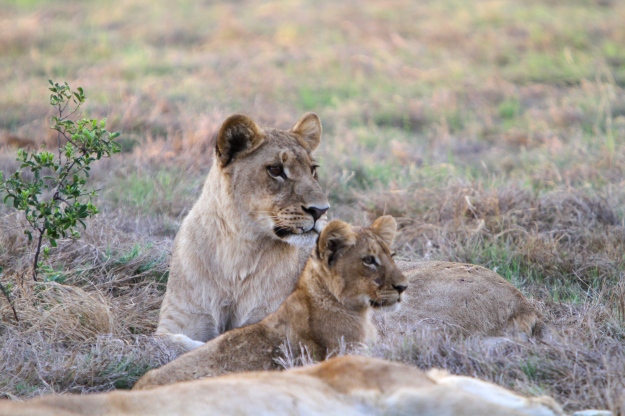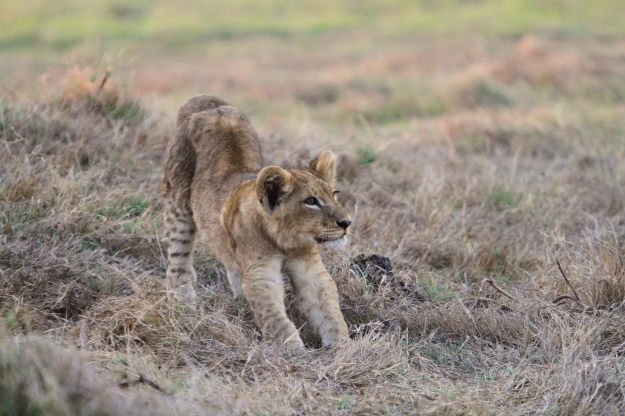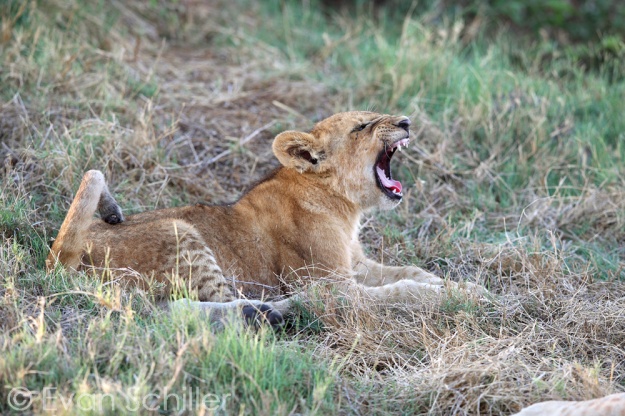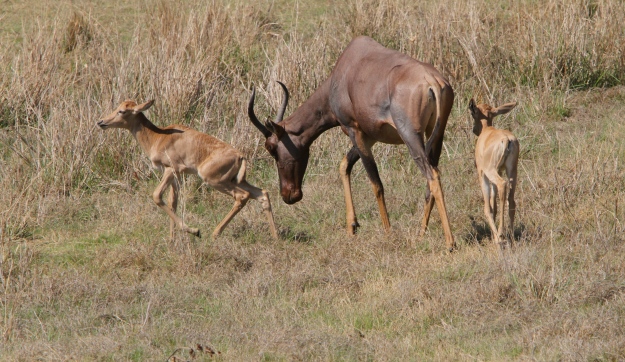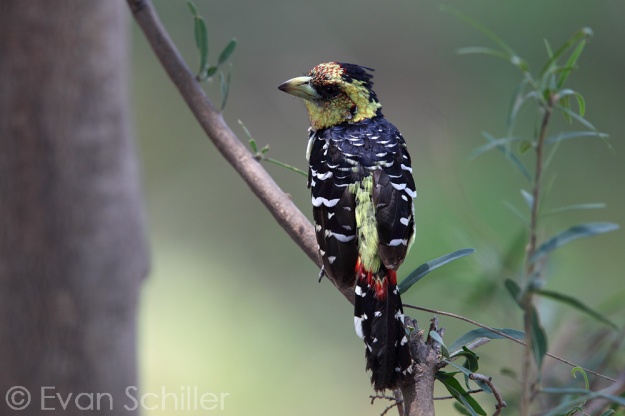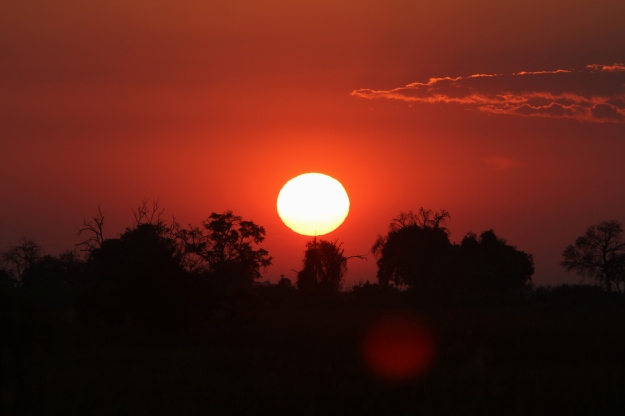Answer: Pussy Galore (that’s for all you James Bond fans, ie., “Goldfinger”).
The picture below represents THREE generations of lions from the Tsaro Pride – Grandmother, Mother, Granddaughter and Grandson
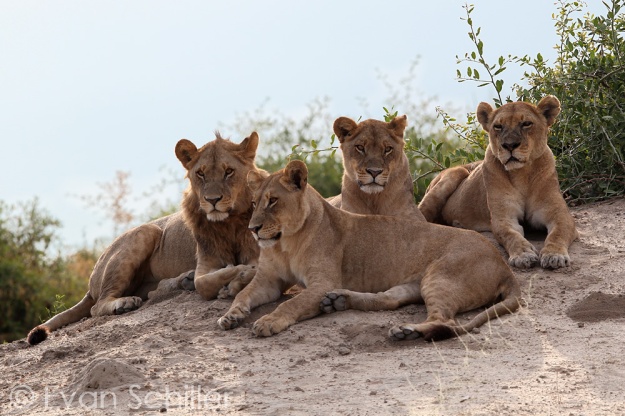
Fearsome Foursome – Photography by Evan Schiller
Duba Plains – November 16 (Afternoon)
The flight from Selinda to Duba took all of 30 minutes on our six-seater plane.
Evan’s quote of the day, “Is it my imagination or are the tents getting smaller?” Ironically, we had started our safari at the most luxurious of the Great Plains Botswana concessions (Zarafa) and had been working our way down to their most “rustic”. And by the way, “rustic” is a relative word as we still were nicely situated on an elevated platform with a thatched roof above our canvas tent which housed a four-poster bed with canopy, desk, chair and bureaus, electrical outlets, as well as indoor plumbing.
A trip to Duba Plains offers a different safari experience. This was a return trip for us – the first trip in 2010 was truly life-changing and an inspiration for our work today. The first thing you need to understand is that Duba Plains is located in the northern reaches of the Okavango Delta, north of the Moremi Game Reserve. It is on a 77,000-acre private concession. Duba Plains partners with the Okavango Community Trust representing the communities of Seronga, Gunotsoga, Eretsha, Beetsja and Gudigwa. The premise for the partnership is that conservation advances rural development by promoting the management of natural resources by the local community, and if the benefits outweigh the costs, than the community is more likely to use sustainable livelihood strategies, ie., choosing to promote an ecological photographic safari rather than a hunting camp (you can only shoot a lion once with a gun, but you can invite guests to shoot with cameras every day for years to come). You wouldn’t know about the Community Trust, per se, but for the fact that someone from the Community rides upfront in the vehicle alongside the Duba guide to make sure that the guide is respectful of the concession and the animals living there. The community representative in essence acts as a second guide in the vehicle and is a wealth of information. Mikopi is the community representative at Duba Plains and we have been fortunate to have him accompany us in 2010 and 2012. This was made extra special by his incredible memory and amazing eyesight – pointing out to us the particular sub-adult lions on this trip that in 2010 were just a few months old (of course his memory might have been heightened by the fact that we had headed out in 2010 on a bleak morning in the pouring rain only to return a “mere” 8 hours later (are you beginning to see a pattern to Schiller/Holzwarth game drives?) – and the only reason we stopped that day two years ago was because we had used up all of our memory cards and my right hand had started cramping from holding down the camera shutter for so long… We used one of Evan’s Duba cubs pictures as the cover shot for our September 2012 fundraising event – and now we were back to see the cubs again! The two pictures below were 2010 pictures – “Hugs” being our cover-shot for the fundraiser. Two of the three cubs in “Scrum” remain with the pride today.
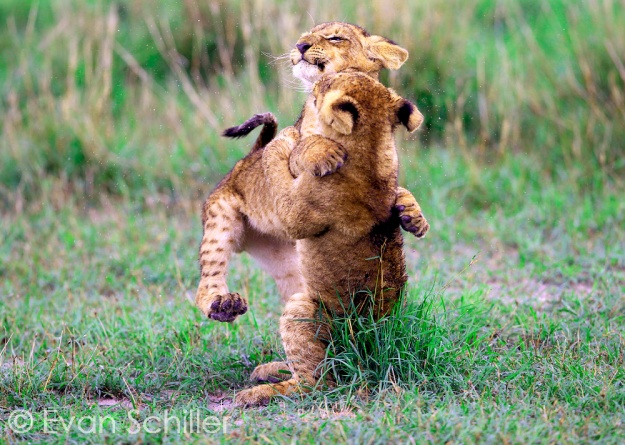
Hugs – Photography by Evan Schiller
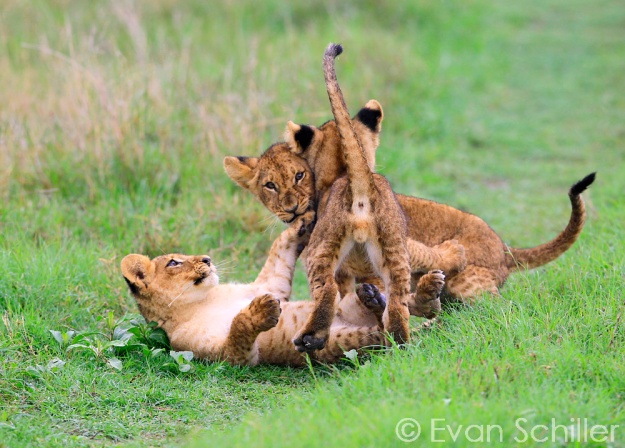
Scrum – Photography by Evan Schiller
The 2010 Duba trip is a story unto itself, suffice it to say that a particular mother lion and her three very young cubs (our first lion cubs) got us hooked on Big Cat conservation. We saw first-hand how difficult it is for the lions (extrapolated to all Big Cats) to raise their cubs to adulthood. Despite the fact that the “King of the Jungle” is at the top of the food chain, life is not taken for granted and each day brings its own set of challenges to the Big Cats.
Duba Plains is an island in the Okavango Delta and, depending on the time of year, will determine where and how deep the water may be. Duba is a combination of open plains and permanent waterways. In 2010 we visited in mid-December, about four weeks later than our 2012 trip. The water was much higher in mid-December than November and this affects the whole dynamic of the animal interaction. (Our personal preference, in retrospect to timing, is December).
Back to my point that a trip to Duba offers a different safari experience… when you go to Duba, you go primarily for one reason – to see the interaction between the Duba lions and the Cape Buffalo. FYI – “60 Minutes” featured Duba Plains in a November 2012 story on Dereck and Beverly Joubert and their work with bringing awareness and saving the Big Cats from extinction. It is also the setting for the Jouberts’ 2011 film, “The Last Lions” and their 2006 film “Relentless Enemies”.
When you go to Duba Plains you will most likely have the opportunity to meet the Tsaro Pride and the Skimmer Pride of lions. There is also a group called the Pantry Pride but I believe their numbers have significantly dwindled. The largest and strongest of the three is the Tsaro Pride numbering about 19 (if you also include the large male known as “the Skimmer Male”, since that is where he originated). You will also inevitably meet the herd of Cape Buffalo that I would guess number over 1,000 (don’t hold me to this, I can’t count that fast). Unlike other safari camps, when you arrive in Duba you immediately go looking for the buffalo herd, because when you find the buffalo, you find the lions. The Cape Buffalo are the lions’ primary food source and over the years the lions have adapted to the habits of their prey. Given that the Cape Buffalo weigh on average between 300-900kgs, they are significantly larger than what most lions in other areas focus on to eat (typically, impala, reedbuck, red lechwe, etc.). When you come to Duba you will also notice that the lions are about 20% larger than other lions you hopefully have been fortunate enough to see. And, unlike at other camps, the Duba lions swim, as well as hunt, during the day (when the buffalo are on the move) and sleep at night, when the buffalo sleep. It is amazing to get out early in the morning to find the Buffs still resting on the ground, the largest of them flanking the edges of the herd with their horns all pointing out towards the waiting lions.
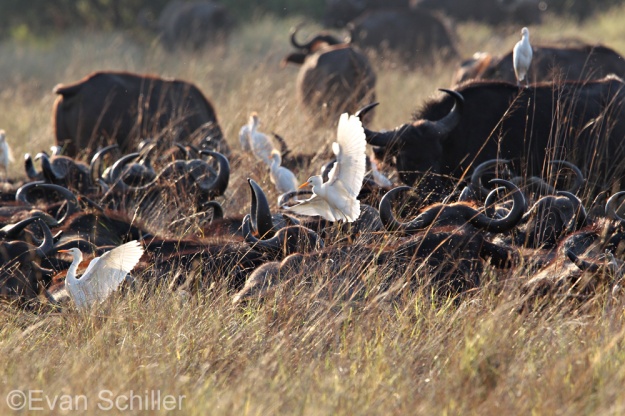
Sunrise with the Buffs – Photography by Evan Schiller
If you are interested in seeing a “big kill” – and be careful what you wish for, there is a good chance you will see such a thing if you get yourself to Duba. In 2010 we were fortunate to see the large Skimmer Male take down, single-handedly, a large pregnant female buffalo. She did not die quietly, they never do. The strength of both animals was incredible. In most cases though, the lions hunt together and on our 2012 trip we were quite fortunate to witness the amazing “Chess Match” that ensued between six members of the Tsaro Pride and the buffalo herd (more on this exciting interaction next post). The lions ultimately pick a target, usually a younger buffalo or one that has found itself on the outer reaches of the herd and work as a group to bring it down. What ends up blowing your mind is how aggressively the herd fights back as a team, often outflanking the lions and forcing a retreat, many times with the lions licking their wounds. Life is not a cake-walk for these big cats…
When it is too hot, the buffalo and the lions rest and the action subsides. In addition to the lions and buffalo, you will inevitably also have the opportunity to see crocodile (remember you are in the Okavango Delta), elephant, hippo, giraffe, and red lechwe. We were also lucky to see the elusive bat-ear fox and the rare aardwolf. You will not see wild dogs here, nor, for all practical purposes, will you see leopards (apparently there may be one here, but it is rarely seen). The wild dogs, leopards and hyena are not part of the Duba equation because the lions are such a BIG part of it. We noticed in other concessions that where/when the lions were extremely active, it was more difficult to find the leopards, and especially the wild dogs. Nor will you see cheetahs, though that is as much because of their incompatibility to the watery terrain as it is to the lions’ dominance. The lions are definitely at the top of the food chain and their presence and activity make all the difference in the world to how that food chain functions.
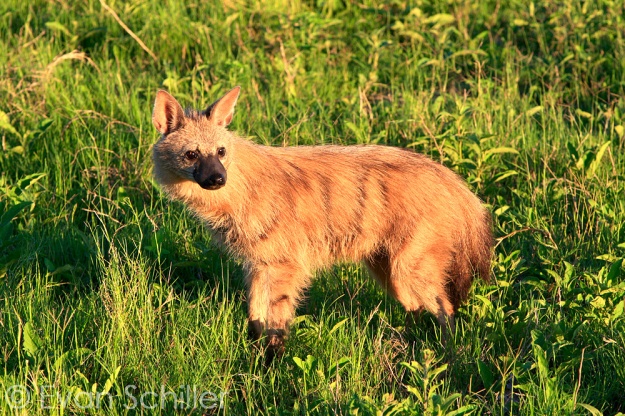
Aardwolf – Photography by Evan Schiller
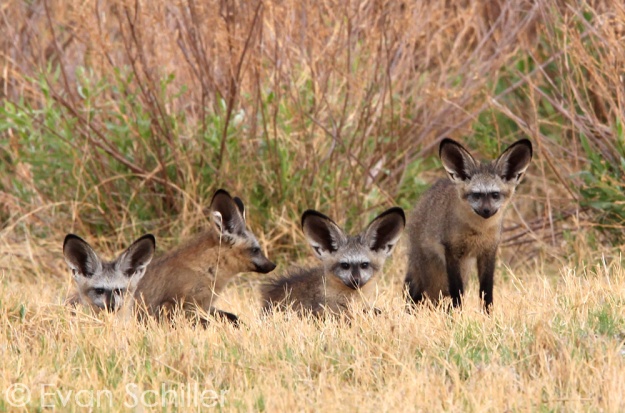
Bat Ear Fox Family – Photography by Evan Schiller
Real-life action with James “007”: Another leading and colorful character in the Duba story is the larger-than-life personality of long-time guide, “James 007” (James Rawdon). James has been guiding at Duba since the concession opened and is a wealth of knowledge and stories. He knows these lions’ habits and behaviors intimately (and I would venture to guess, they know his…). It is rare that a guide stays at any one camp for years on end, but James is from the community and his devotion, love and respect for the Duba Plains concession is self-evident. In addition to being masterful with and around the animals, he is also an expert on “guest relations” and I would guess over the years he has accumulated almost as many guest stories as he has animal ones. One of the challenges of hosting multiple parties in a single vehicle is that everyone has their own agenda and, yet, every day everyone has to agree on (1) what time we depart on the morning game drive, (2) how long we watch a particular animal, (3) which animal we decide to track/watch (this is less of an issue at Duba), (4) how long we stop and when we head back for lunch and dinner. You can just imagine a vehicle chock full of entitlement and what a guide must maneuver through on a daily basis… this leads me to rationalizing for you why Evan and I felt it was money well spent to hire a private vehicle, thereby circumventing the need to compromise on our mission.
Private Vehicles – to be or not to be? And the Great Compromise: We had been incredibly fortunate in 2009 and 2010 that we happened to find ourselves with either like-minded photographers or by ourselves with our guide in the open air 4-wheel drive vehicles. We made the calculated decision for this trip that it would be the better part of valor to pay the added expense of getting a private vehicle so that we would have 100% vote on what we tracked and how long we wanted to stay with a particular animal. This proved to be well worth the extra expense for us on this trip given that we have a lot more patience than the average guest and we were very intentional on what and where we wanted to place our attention. Given some logistical issues, we unfortunately found ourselves on our initial two game drives at Duba without a private vehicle…
Now – to the Afternoon Game Drive: Upon arrival at Duba, we quickly unpacked our cameras and headed out to join the other guests who had already left that morning on what was to be an all-day drive. We met up with everyone for a beautiful buffet lunch on the open plains with the Cape Buffalo grazing in the foreground (of course the lions were also in the general vicinity, but it was hot and the guides felt comfortable that they weren’t going to stray too far in the heat of the day – that being said, they didn’t want anyone of us to venture very far either (including to relieve themselves). I have never been a fan of peeing in bushes so I continued to avoid exposing my backend to any surprised creature – man or beast).
James finally gave the signal that we would start the afternoon drive and Evan and I joined a vehicle that already housed three guests. There’s always a bit of a dance on where people sit and some spots are considered more desirable than others. Since we were the last to arrive, we found ourselves in the last two seats (with me in the very last seat). Given the configuration of these very low-geared, but high off the ground 4-wheel drives, the ride is never smooth and gets bouncier the further back in the vehicle you sit. I was trying to hold onto all my gear as we bounced around for the afternoon in 100+ degree Fahrenheit heat cursing to myself. It didn’t take long for the guests who had been out since early that day (and where there had been little action) to get tired. The heat was getting to everyone, but Evan and I had just arrived and we wanted to find the cats that everyone had already watched all morning. We all found ourselves in somewhat of a lose/lose situation. It was James’ job to negotiate a major compromise (the other guests stayed out longer than they wanted and Evan and I stayed out shorter than we wanted) – perhaps he should take his negotiating skills to Washington DC and see what kind of Great Compromise he can generate there?? No one was completely satisfied, but as a hedge fund manager once said to me, a good compromise is “when everyone walks away feeling a little short-changed”. I am sure that if there had been more action involved, the choice would have been different. The one thing the afternoon confirmed for us is that we had made the right decision on having a private vehicle as much as it was possible. And the reality for all you future safari-goers is, sometimes a drive is a little more quiet than others – don’t despair, part of the fun is never knowing what you will find around the corner…
Here are a few of the pictures we did capture that afternoon of some very hot, lethargic lions from the Tsaro pride. There were two young cubs (probably about 3-4 months old you were being baby-sat by some of the sub-adults in the Pride while their mother was away – there was one particular young sub-adult male with the patience to put up with their antics while everyone napped in the heat.
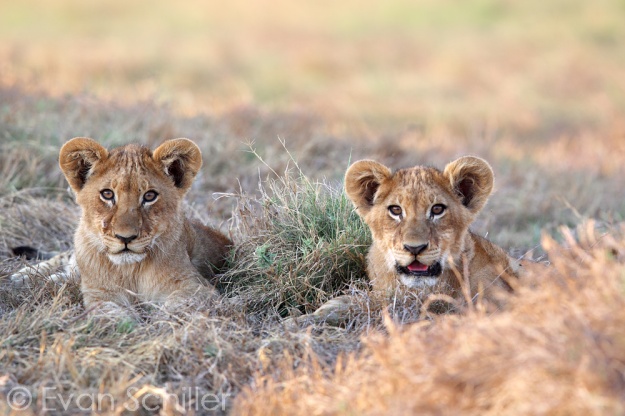
Duba Cubs – Photography by Evan Schiller
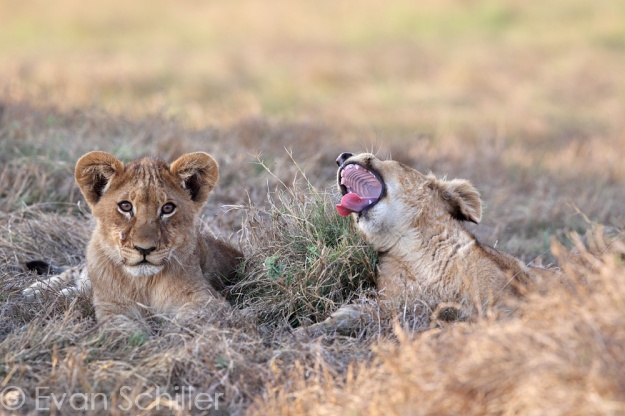
Duba Yawn – Photography by Evan Schiller
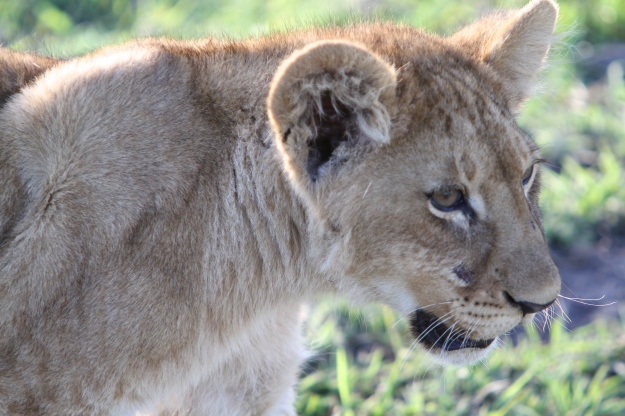
Little Tsaro Guy – Lisa Holzwarth
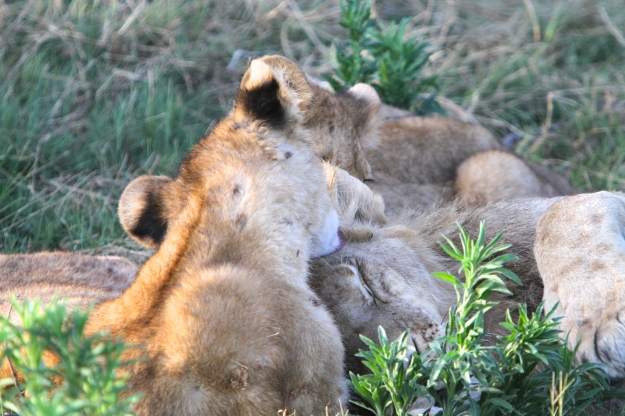
Siesta, interupted – Lisa Holzwarth

